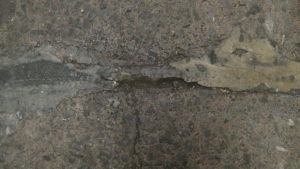Have you patched concrete holes, divots, or damaged joints only to have them fail days or weeks later? Failed concrete repairs is not uncommon in warehouses and factories across the country. These issues cause major frustrations for facility managers with slowed production, damaged forklifts, lost or damaged products; and with so many other things to juggle as a plant manager, the concrete floors often get neglected, making the issue worse. Learn more about comprehensive concrete floor repair services here.
Main Causes of Failed Concrete Repairs
- Surface Prep – Proper surface preparation is key to making sure concrete repairs last. The best way to avoid failed concrete repairs is to cut deep, square edges for the product to adhere to. With clean and square edges the repair product locks into the concrete and doesn’t have the same change to pop out as easily. Further, a proper primer will penetrate into the softer substrate to lock the patch in and increase its bond. Finally, Once the repair material is installed and cured, the patch is ground flush with the existing concrete locking it in again and ensuring that there are not places of impact for forklifts.

- Product Selection – Epoxies often lead to failed concrete repairs. They do not have a primer coat that provides additional bond or bite into the substrate, they are often left un-ground flush with the concrete, and many times they are poured into dirty concrete holes.

Failed Epoxy Repair
- Fusing Joints Closed – If repairs are made over concrete joints and the original joint is not honored (cut back through the patch), this can weld the joint closed. Because joints are there to provide thermal movement in the concrete when the changes occur. If the joint is welded shut then when the concrete moves it will crack and crack the patch. Once the new patched is re-cracked it can cause the entire patch to pop out or cause worse damage to the concrete
 Permanent fix for Failed Concrete Repairs
Permanent fix for Failed Concrete Repairs
- Properly Installed Reactive Resin Mortars – Reactive resin mortars are superior to epoxy or concrete patches because they can cure in 45 minutes, they can cure in below-freezing temperatures, and they cure to 12,000 psi in 1/4″ making the over double the strength of concrete. If the concrete is properly prepped, cleaned, and primed, the reactive resin mortar should be a permanent solution for failed concrete repairs.
- Slab Stabilizing – To further remedy the slab permanently, slab stabilizing tools are used. If the slab is rocking due to unstable soils or subbase or lack of rebar, slab stabilizing can stop the movement of your slab and make the repairs last. Slab stabilizing foam can be injected under the slab to fill voids. This lightweight foam does not risk further soil compaction, but is strong enough to hold up the slab. Further, slab stabilizing devices can be installed to lock the joints together and eliminate rocking slabs. Slab stabilizing coupled with proper repairs will eliminate failed concrete repairs and restore your slab to a worry-free floor.
Titus Restoration is a concrete restoration contractor specializing in advanced concrete repairs. Our repairs are performed with high quality products and procedures designed to withstand the heaviest of industrial warehouse traffic. Our experts are available to answer your questions and provide an evaluation of your facility. Contact us today!
